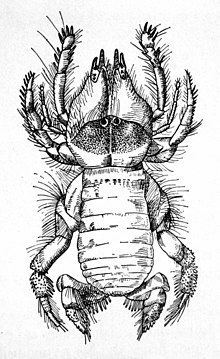Order Sun spiders | Rank Genus | |
 | ||
Similar Sun spiders, Daesiidae, Solpugidae | ||
Chelypus ('clawfoot') is a genus of slow-moving, burrowing sunspiders confined to the deserts and arid regions of Southern Africa. The known species of the family Hexisopodidae, also called Mole Solifuges or Teddybear Solifuges, are from two genera - Chelypus with 6 species and Hexisopus with 15 species. They are readily separated from other members of the Solifugae by an absence of claws on the fourth pair of legs. Both Hexisopus and Chelypus spend a large part of their existence underground, so that their 2nd, 3rd and particularly the 4th pair of legs, are shortened and robust, and equipped with rake-like spines for digging.
Members of the family Hexisopodidae differ markedly in morphology from those of other solifuge families - most patently in their fossorial rather than cursorial legs. Such extreme modifications often blur relationships with other taxa, and hexisopodid genealogy is no exception. The family Hexisopodidae Pocock 1897 is endemic to Southern Africa (mainly in South Africa and Namibia, but also in Angola, Zimbabwe, Zambia, and Botswana). The main external difference between Chelypus and Hexisopus is the presence of well-developed spines on the pedipalps of Chelypus. Its subterranean way of life makes the family extremely difficult to study.
The current phylogeny of solifuges is lacking in any subordinal or superfamilial arrangement and is largely based on the scheme put forward by Carl Friedrich Roewer in 1934, relying on highly variable characters at both genus and species level. Roewer's system has been challenged by various taxonomists and authors.
